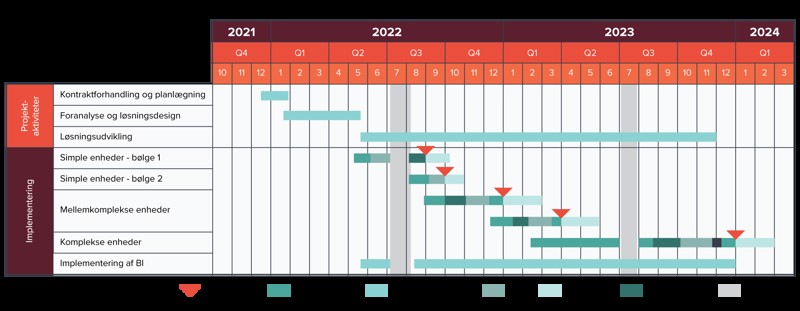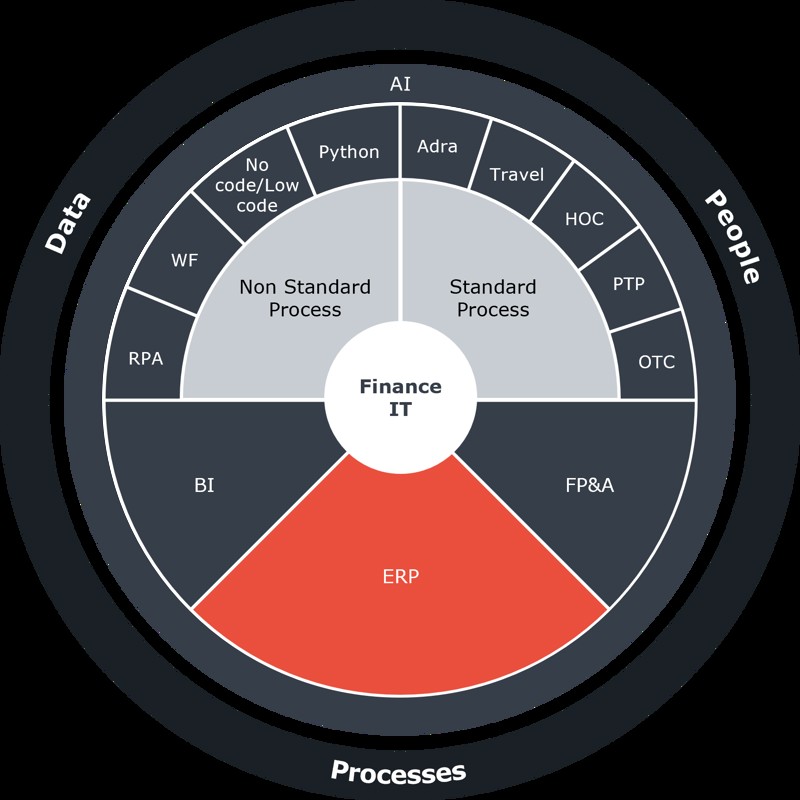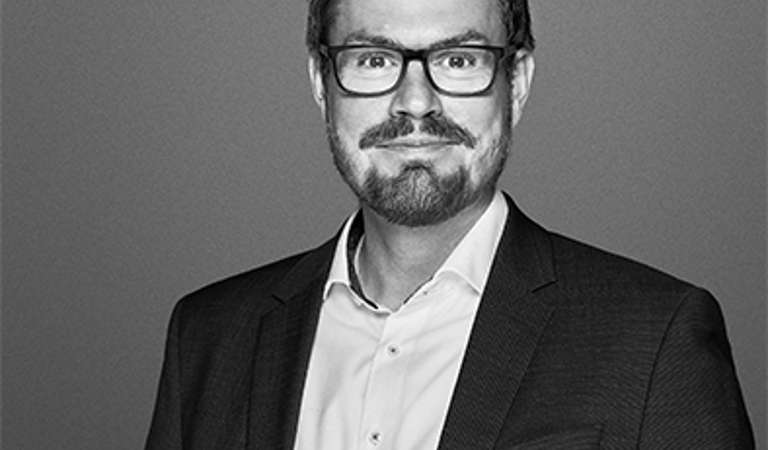How do you implement 86 accounts into a unified ERP landscape? This was the complex task faced by Jens Bakke, IT Manager at Landbrug & Fødevarer. With an extensive year-and-a-half preliminary analysis, followed by dividing the ERP project into five phases, he ensured optimal overview, thereby significantly improving the chances of selecting the right solution.
As we arrive at Landbrug & Fødevarer’s office at Axelborg and step inside the captivating building, we are overwhelmed by the majestic atmosphere that envelops the place. On our way up to the interview, we are transported by an old-fashioned paternoster lift, whose gentle, continuous movement almost feels like a journey back in time.
Jens Bakke, the IT Manager at Landbrug & Fødevarer, greets us with a big smile in the meeting room.
Right from the start, you can sense that Jens Bakke is a passionate man with a firm handshake and a sparkle in his eyes. Everyone in the room knows we are about to delve into the story of an extensive project, and before we begin, we take a sip of our hot coffee.
“"One word that describes our entire ERP project is: complexity," Jens Bakke begins with a smile, taking another sip.
“But to understand the starting point of our ERP implementation, you need to understand how Landbrug & Fødevarer is structured as a business," he continues, explaining that Landbrug & Fødevarer is a large enterprise with many smaller organisations, foundations and associations under its wing.
And this means they have a plethora of different systems, processes and methods.
When Landbrug & Fødevarer was formed in 2009, it was not just many organisations that came together – it was also a merging of different cultures. So, even though the organisations may have common interests industry-wise, they have vastly different starting points and cultures.
“That is one of the reasons why it has been challenging to align our processes," Jens Bakke explains.
About Landbrug & Fødevarer
Landbrug & Fødevarer is a central enterprise representing Danish agriculture, the food industry and the agribusiness sector. With more than 30,000 members and around 2,800 affiliated companies, Landbrug & Fødevarer covers a wide spectrum of actors within the agriculture and food sectors.
The enterprise works purposefully to strengthen the industry's competitiveness, sustainability and innovation. This is achieved through a range of complex initiatives, including consultancy, political influence and in-depth statistics and analyses.
A journey towards uniform systems
When Jens Bakke started the project three years ago, Landbrug & Fødevarer had four outdated ERP systems across the organisation. They wanted to change this structure because the technology was obsolete and, on a strategic level, it hindered the company's development.
Additionally, there was great potential for increased collaboration across departments and breaking down silos. We will delve into this later, but first, we need to get all the details in place.
Jens Bakke explains: "Over a period of ten years, Landbrug & Fødevarer has unsuccessfully attempted several times to replace the old systems with a new integrated solution. The reason is that the old systems were tailored to the specific areas where they were used. Therefore, there were different ways of solving similar tasks across the entire business. To function in a shared system, a common model was needed."
Landbrug & Fødevarer not only manages their own accounts but also the accounts for their associations and foundations within the industry. Originally, they needed to move 86 accounts.
With over 20 years of experience in ERP implementations, Jens Bakke knew that handling this complex task required a structured approach and a clear overview of the entire system landscape connected to the existing ERP solution. He therefore began with a thorough mapping of the current systems and processes, identified critical needs and prioritised them accordingly.

Jens Bakke, IT Manager at Landbrug & Fødevarer
The core of complexity: Creating a common model
It turned out to be a somewhat larger task than expected.
“I tried to establish a common framework, and that became a significant part of my preliminary analysis," says Jens Bakke, continuing
“But there were a lot of details due to our many different systems and processes. We had to go around each area of the business to gather all the necessary knowledge. And that is where we have had a challenge – what should the system be able to do? It depends on which area you are in, and what processes are running."
Jens realised that it was not possible to be everywhere at once, and that conducting such an extensive analysis and interviewing everyone in the company would take several years. However, he also knew it was necessary to create an 'as-is' picture at a level that would allow for the development of their 'to-be' picture.
"There is, of course, an advantage in moving from four main systems to one, as we did at Landbrug & Fødevarer with the ERP implementation. This has meant, among other things, that we could streamline workflows and that employees working in the system can cover for each other, for example, during holidays and illness. There are many more benefits to be reaped in the future, as work can be done more smartly, and tasks become more enjoyable when manual tasks are replaced with more value-adding ones."
The importance of a thorough preliminary analysis
Before we dive into how the ERP implementation itself took place, Jens Bakke takes another sip of his coffee and thinks for a moment. He wants to emphasise that before embarking on the implementation of a new ERP system, one of the most important disciplines is the preliminary analysis.
“Every ERP project is unique, and the preliminary analysis is a crucial component for the project's success. Things often go wrong if you have not grasped the complexity or have misunderstood something before the implementation. Therefore, we delved deeper to find the root of the challenges and spent 1.5 years on the preliminary analysis. This way, we could sort out more details and discuss what the 'to-be' state should be."
The choice of system ended up being Microsoft Dynamics 365 Business Central, as the system was deemed capable of supporting the business' needs. "Two of our four ERP systems were already Navision solutions, which have the same foundation as Microsoft Dynamics 365 Business Central, providing a certain familiarity for some of the users. The other two were Unik and Schilling, and the users did not work across the systems. Therefore, they primarily knew how to use their 'own' system," Jens says with a smile.
He continues: "With that as a basis, I prepared a tender document where I omitted listing all the standard features. Instead, I focused on the requirements that needed custom development, as I know the product thoroughly. We sent this document to four suppliers, and eventually, we chose one of them.”
Five go-live dates
With the preliminary analysis well underway and the choice of supplier settled, we can now begin the story of the ERP system implementation.
Due to the complexity of the project, Jens Bakke decided to divide the implementation into five different go-live dates. Often, the approach would be a major Big Bang launch, where everything is rolled out simultaneously, but that would have been too large a task to handle at once, hence the phased approach.
“I established some rules for how we could divide the implementation into several waves depending on complexity. If we had tackled all 86 accounts at once, it would have been difficult to keep up and resolve any issues. It was also necessary to break it down because the processes were not yet fully established. We developed a detailed plan for the ERP implementation, which included communication and training to ensure that all affected parties were informed and ready for the changes," Jens Bakke explains, showing their comprehensive project plan.
The first phase included the simplest accounts, allowing employees to become familiar with the user interfaces, as not everyone had the same background and experience with Navision.
The project team created a standard account, which formed the basis for all the other accounts in the first wave.
When they subsequently corrected errors or added new functionality in the accounts that had already been implemented, they simultaneously updated the standard account.
Subsequently, they moved on to a more complex phase and adjusted the standard account based on new experiences, so previous errors could be avoided. In this way, they could gradually build on their knowledge.
In January 2024, they launched the fifth and final batch, which was both the largest in volume and the most complex.

The overall project plan for the ERP implementation at Landbrug & Fødevarer illustrates the project's complexity with five go-live dates that have contributed to its success. It provides a comprehensive overview of how complex ERP systems are rolled out, covering everything from contract negotiation and planning, preliminary analysis and solution design to the development and implementation of simple, moderately complex and complex units, as well as BI.
Improving workflows and breaking down silos
By employing this systematic approach, they were able to gradually migrate and integrate the different accounts and processes, thereby ensuring a more consistent and efficient operation.
And many of the users already had experience with Navision, which made the transition easier for them.
In contrast, the employees who previously worked with Schilling faced a steep learning curve, as the systems and functionalities were more different. This made it challenging for Jens Bakke to plan training that suited everyone. He therefore chose to offer general training, knowing that it might not necessarily meet each employee's needs, but with the aim of ensuring that everyone could adapt to the new solution.
Jens Bakke takes the floor and smiles: "Basically, no one likes change. I have been in the industry for many years, and when changes occur, the new should be like the old. Just better," he laughs.
“But the limitations of the old systems were so significant that many were really pleased with the new possibilities in the new system. Previously, we relied on folders, and one often had to find a specific folder to retrieve a guide for a particular process. The new transparency will also reduce errors in the future – especially as knowledge flows across departments," Jens Bakke elaborates, pausing for thought.
“Now we have a uniform starting point, and we have already standardised many processes. This has broken down the silos among employees, systems and departments. For example, those who worked in Schilling versus those who worked in Navision – they did not fully leverage each other's competencies. Now, employees can cover for one another when they are ill, and if there is a peak workload, someone else can step in more quickly," he says.
Remember the internal anchoring
We could continue the good conversation with examples of how the digital transformation has borne fruit, but we are curious and have a handful of questions for Jens Bakke.
Therefore, we ask for the good advice Jens Bakke has for companies facing a complex system and process upgrade, such as replacing an ERP system.
The first immediate response comes promptly from Jens Bakke: "Hire someone with knowledge of ERP implementations," he smiles. He continues: "When implementing an ERP system, the most important thing is to focus on internal anchoring. On average, Danish companies change ERP systems every 10 years. Therefore, it is rare for anyone to have experienced it more than once in a company. And those who have, may only have been on the sidelines.”
Jens Bakke has also sat on the other side of the table as an ERP supplier.
Therefore, he knows that it is often the supplier who drives the process, but the employees must have the right prerequisites to reach the goal. It is extremely important to have a dedicated support function, internal employees or super users who understand the questions posed by the suppliers; otherwise, the project can quickly go off track.
He shares his second piece of advice: "The phased approach to our ERP implementation has been crucial to our success, as it made the task manageable. So, I would recommend taking the project in small bites, being aware of your processes and having a clear vision for the future. Consider which challenges you need to solve. It is much easier to train your employees when you have established the desired process," he elaborates.
Jens Bakke also points out that it is equally important to get the right external advice if the company does not have experience in the area. It is necessary to have a link between the business and the ERP supplier.
“This is where Basico's consultants come into play, operating at the intersection of business, guidance and coding. They focus on what the solution should be and ensure it is business-coherent. It is a significant advantage to be able to internally translate the questions correctly so that the decision-makers in the company understand what they are considering, as well as the advantages and disadvantages.”
"The project has been well planned and communicated. We have avoided periods where we in the finance function could not report or view the figures during the conversion to Microsoft Dynamics 365 Business Central. And although it is always challenging to get used to a new system, the employees in the finance function have embraced it well. Basico has also been a great help with professional support for the employees who have struggled with the system, and they have provided assistance when we needed additional hands with specialised skills."
The next steps on the digital journey
It is clear that Jens Bakke has established a solid foundation with a uniform platform. But before we conclude the interview, we ask about the next step in Landbrug & Fødevarer's digital journey:
“Our next step is to further standardise our processes. There are still some process areas that require even more focus – and this involves the entire business, not just accounting."
“The more we can standardise the processes, the better employees can handle tasks across areas and cover for each other's responsibilities. The digital transformation has not only streamlined processes but also promoted collaboration and flexibility among employees. This has resulted in a more cohesive and productive environment," Jens Bakke concludes with a satisfied smile.
We unfortunately cannot predict the future …
Therefore, things may have changed since our articles were published – contributors may have changed jobs, and the world may have been turned upside down by American presidents and other catalysts for unexpected events – you get the point. Since we visited Jens Bakke, he has changed obs and is therefore no longer employed at Landbrug & Fødevarer. Today, Jens Bakke is employed as Director at Basico with a focus on ERP implementation.
Holistic advice
When we assist in digitising and automating financial functions, we tailor applications and tools that meet your needs. We do this in a way that ensures the solution best supports the data, processes and the people working behind the scenes.
The illustration shows Finance IT Services’ digitalisation circle, representing the skills we can deploy when your company’s financial processes need digitising – always with a holistic approach.

Basico's digitalisation circle

Is an ERP project knocking at your door?
We have assisted many companies with pre-planning and independent advice regarding ERP projects. Our experience shows that a successful ERP implementation requires a thorough understanding of your company's unique needs and challenges. That is why we work closely with you to ensure all aspects of the project are meticulously planned and coordinated.
Feel free to contact us for a no-obligation discussion about how we can help you achieve your ERP project goals.

 en
en
 da
da



